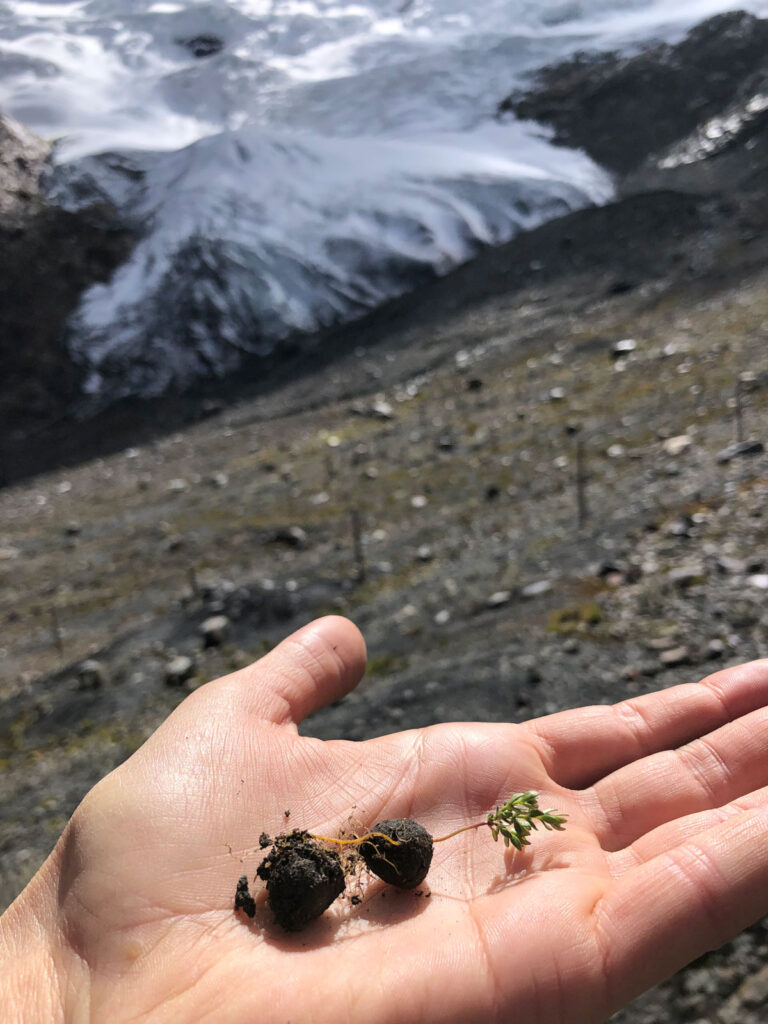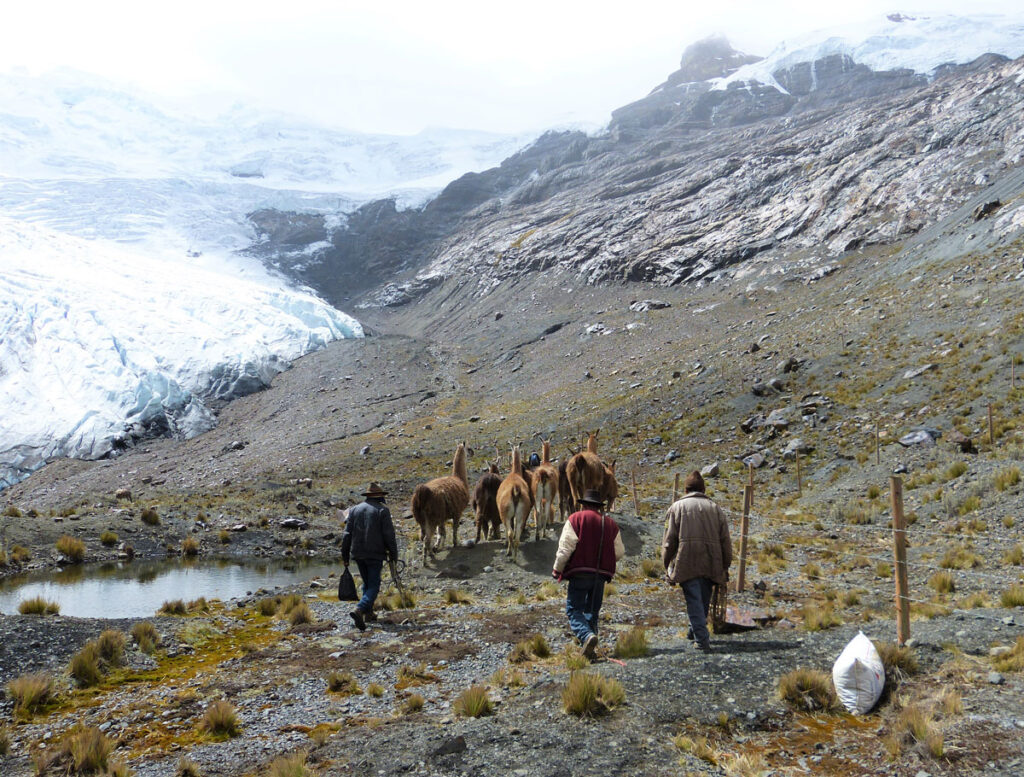Ecologist Anaïs Zimmer was walking in the Peruvian Andes one day, explaining to community members how hard it is for vegetation and soil to establish itself in deglacierized areas, or areas where glacier ice is retreating. That was when locals suggested an unconventional solution: bringing in llamas to fertilize the soil with their poop.
Zimmer, then at the University of Texas at Austin, had been studying the consequences of glacier loss in the Andes for the past decade. Peru, which is home to 70% of the world’s tropical glaciers, has lost more than half of them in the past 50 years because of climate change, according to the country’s ministry of agriculture. When the ice disappears, it uncovers metallic, rocky soil that had been covered for millennia. It can take hundreds of years for fertile soil to develop and vegetation to fully establish itself in the newly exposed, nutrient-poor grounds.
In the meantime, these bare swaths of land increase the risk of floods and landslides for downstream populations. In the Cordillera Blanca (Spanish for “white range”) of the Andes, the heavy metals present in the rocks also contaminate rivers and other water supplies.
But an ancient practice might offer a solution to these problems. The introduction of llamas, a camelid traditionally herded by native Inca populations, can speed up soil and vegetation development in areas of glacier retreat, suggests new research published in Scientific Reports.
“Raising llamas was an ancestral custom since prehistoric times,” said Jorge Mattel, a primary school teacher and president of the Llama 2000 Association, a group of Andean herders who raise llamas to recover their cultural identity and foster tourism in the mountains.
Llamas Give Seeds a Ride
Despite their importance to local culture, llamas disappeared in the Cordillera Blanca in the 19th century because of the expansion of cattle and sheep farms, as well as large-scale agriculture, that today cover significant parts of the region.
The locals helped Zimmer realize llamas could act as natural gardeners, not only fertilizing the soil with nutrient-rich poop but also spreading seeds. After the llamas eat plants from the mountains and lower grasslands, they can carry seeds in their stomachs, wool, and hooves up to the high altitudes of the glacier forelands.

“Plants that are not dispersed by the wind need much more time to go up the mountains,” Zimmer explained. “And it was very likely that llamas could disperse different plants from lower lands to the high-altitude proglacial habitat.”
The researchers tried this idea in a deglacierized area 5 kilometers above sea level in the Cordillera Blanca’s Uruashraju glacier foreland. In partnership with the Llama 2000 Association, they established eight fenced plots in a protected area within the Huascarán National Park.
Llamas were left out to graze in four of the plots, whereas the other plots remained untouched. With the herders’ help, the scientists fine-tuned details, such as how many animals to place in each plot and when to move them out of the plots to graze.
“It was very important that [the herders] were integrated into the study,” Zimmer said. “They helped to answer important questions with their unique knowledge.”
Poop-Powered Gardens
To test the effects of the llamas, the researchers collected and tested samples of the dung, soil, and plants in the plots. After 3 years of monitoring, they found that plant cover in the areas with llamas increased by 57% compared to the plots without the animals.
The llamas also brought new seeds to the high-altitude regions of the melting glaciers. The researchers found seeds of 12 plant species in the animals’ dung. Five of the species proved able to germinate in lab tests, and four were found only in the plots with llamas.
“We think that with more years of experiment, we will see an increase in biodiversity and richness of plants in the plots with llamas.”
“We think that with more years of experiment, we will see an increase in biodiversity and richness of plants in the plots with llamas,” Zimmer said. She expects the llamas will help to develop the typical local vegetation, including woodlands, grasslands, and wetlands.
Zimmer hopes the results can encourage similar interventions on other glaciers, especially with wild animals that don’t need much assistance. An unrelated study with vicuñas, a wild cousin of the llamas, also showed that these animals promoted islands of vegetation where they pooped.
Ecologist Kelsey Reider of James Madison University, who led the study with vicuñas, welcomed the new research with llamas. However, she pointed out that neither of the two studies presents enough evidence to recommend specific interventions to local communities.
Reider noted that although the presence of these animals in the glacier borders could help increase pasture in the region, which is decreasing along with water availability, it is uncertain whether these kinds of interventions would come soon enough to be useful.
“We don’t know in what timescale the landscape would be productive enough to benefit the communities,” she said.
Possible Contamination Solution
Community members like Mattel hope the llamas will also help reduce water contamination. Today, Andean communities face problems that include heavy metal poisoning, the disappearance of fish, and crops damaged by acidic water.

Mattel said he has many friends struggling with stomach cancers he believes are linked to the contamination. “We can’t drink or irrigate our potato crops with water from the river,” he said. Without a local water treatment system, they depend on rainwater, which is often insufficient.
Zimmer thinks better vegetation coverage could help filter heavy metals out of water because some plants can absorb such metals through their roots or leaves. Her next studies will evaluate whether the presence of llamas helps reduce the concentration of heavy metals in the soil.
“We are convinced that this cooperation will be very important because, without scientific and technical support, we won’t be able to adapt to the problems brought by climate change.”
“We need more time to analyze water and plants to understand if a more developed soil has the capacity to clean the heavy metals,” Zimmer said. “If the llamas can enhance ecosystem formation and formation of wetlands, maybe they could help in this process too.”
Mattel puts his hopes in this partnership with researchers: “We are convinced that this cooperation will be very important because, without scientific and technical support, we won’t be able to adapt to the problems brought by climate change.”
—Sofia Moutinho (@sofiamoutinhoBR), Science Writer
This news article is included in our ENGAGE resource for educators seeking science news for their classroom lessons. Browse all ENGAGE articles, and share with your fellow educators how you integrated the article into an activity in the comments section below.


